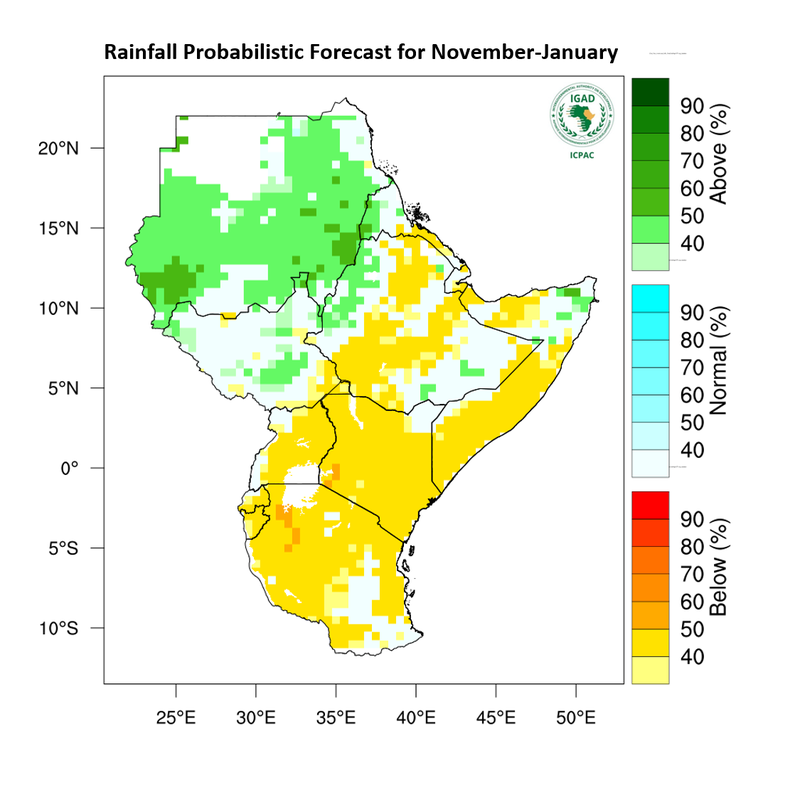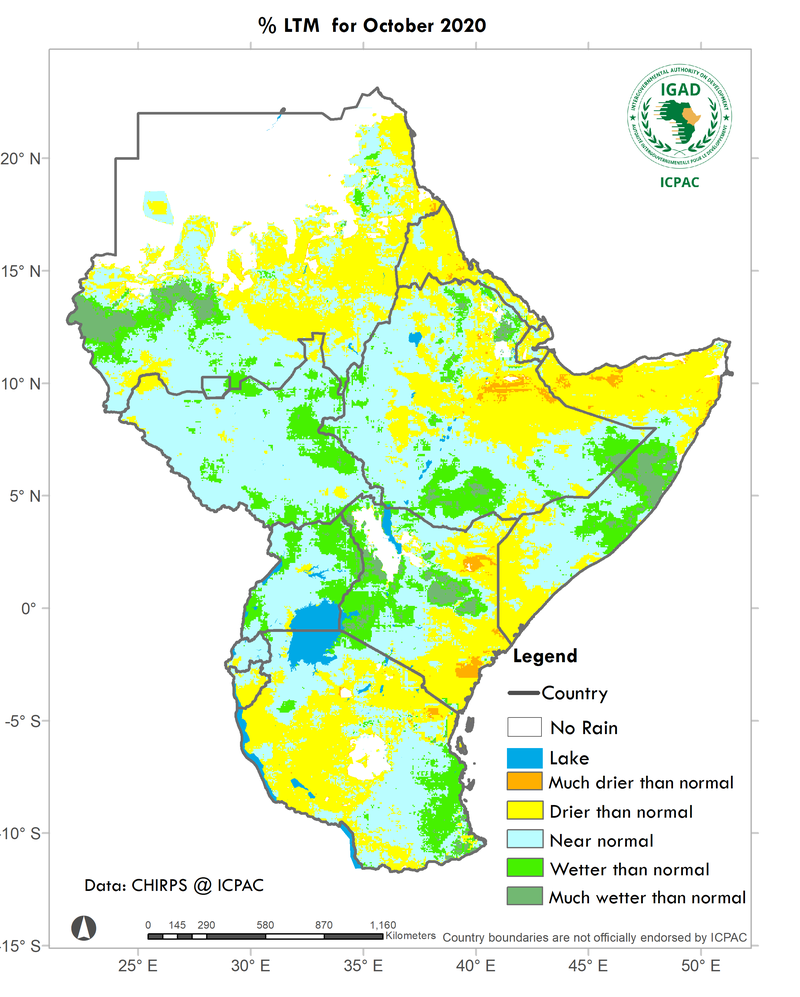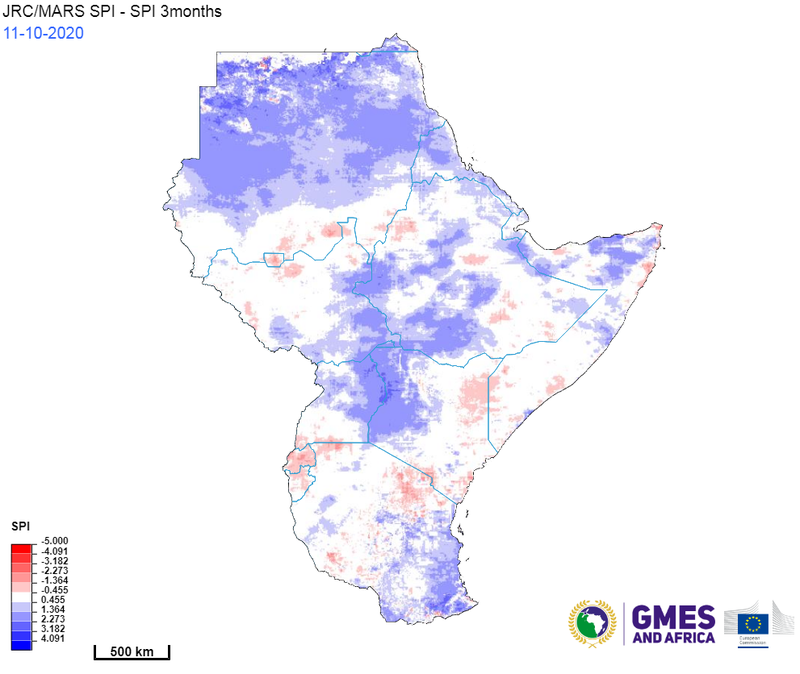La Niña: forecasted drier than usual season poses risks to crops and livestock in some parts of the region
While East Africa is still battling multiple shocks, a drier than usual season due to La Niña could pose risks to crops and pastures in some parts of the region
Nairobi, 11 of November 2020: October to December is a major farming season for Kenya, southern Somalia, southern Ethiopia, Rwanda, Burundi, Uganda, and much of Tanzania. The drier than usual season might impact southern Ethiopia, northern and western Somalia, eastern and western regions of Kenya, northern Tanzania, and other sparse areas around the region. Drier than usual conditions are forecasted to continue until January 2021 due to a La Niña event in the Eastern Pacific Ocean. Although risks are uneven across the region, stakeholders are advised to remain vigilant since the risk of receiving lower than usual rainfall in some farming areas comes at a time when some countries are still facing the impacts of desert locust, floods, and COVID-19.
For farming communities, this could lead to poorer than usual harvests, due to reduced rainfall when crops are at the reproduction stage. The resulting poor nutrition status may reduce the immunity of all age-groups, further complicating the vulnerability to the possible effects of COVID-19. For pastoral communities, poor rains could lead to a shortage of pastures and water for livestock, consequently leading to scarcity of milk and meat production, and declining livestock prices due to poor body condition. The overall poor food and nutrition security could increase the levels of acute malnutrition among infants and young children. Atypical cross-border livestock migrations may spark resource-based conflicts.
Poor production prospects could undo the gains made from the past two favourable seasons and could lead to a deterioration in food security in some parts of the region in early 2021. There are already 29.5 million people in IGAD countries who are in urgent need for food assistance (IPC Phase 3 and higher). The region also hosts 44.8 million people currently Stressed (IPC Phase 2). These are very vulnerable to climatic shocks and can easily slip into Crisis (IPC Phase 3).
Key messages:
- A drier than usual season is forecasted to continue into January 2021 in some parts of the region due to a La Niña event in the Eastern Pacific Ocean. La Niña increases the risk of having two consecutive drier than usual seasons in East Africa (eg. 2010 - 2011)
- Rainfall performance to date in October has been mixed. While some parts of the region experienced rainfall deficits (eastern and central Ethiopia, southwestern Somalia, eastern Kenya, north-eastern and south-western Tanzania), other parts received higher than usual rainfall (western and central Kenya, eastern Uganda, some part of southern Ethiopia, and central Somalia).
- Countries are advised to remain vigilant despite the two recent good rainfall seasons. Multiple simultaneous crises could drive deteriorations in food security in certain areas. 29.5 million people are already food insecure in IGAD countries.
- Communities across the region are still facing the impacts of desert locust, floods and COVID-19 and are having very little time to adapt between Climate Shocks
- 2019 and 2020 have been years of climate extremes for Eastern Africa, with many records broken in terms of rainfall, rising lakes (Lake Victoria reached its highest level on record) and floods (The water level of the Blue Nile in Khartoum reached a height record in August 2020).
- Countries are advised to implement mitigation measures to respond to the possible health and nutrition effects of the forecast and avoid further losses to lives and livelihoods
Note to editors:
La Niña refers to cooler than usual ocean temperatures in the eastern part of the Pacific Ocean, which occurs on average every 3 - 7 years. It usually affects temperatures, precipitation, and storm patterns in many parts of the world. In East Africa, La Niña results in drier than usual seasons. According to the World Meteorological Organization (WMO) the current La Niña event could last until 2021 and is expected to be moderate to strong. The last time there was a strong La Niña was in 2010-2011, followed by moderate events in 2011-2012 and 2017 - 2018.
Contact details for Interviews:
abubakr.babiker@igad.net
Resources:
- WMO Press Release: La Niña has developed
- Seasonal forecast update (November 2020 - January 2021)
- Resources: IGAD Bi-annual Meeting on Food Security and Nutrition
- FSNWG Food Security Alert
- Summary for Decision Makers
Rainfall forecast Nov - January 2021

ICPAC's forecast for November 2020 - 2021.
Observed rainfall in October 2020
Rainfall observed in October 2020 compared to the long-term mean of October (1981 - 2010). Yellow to brown areas experienced rainfall deficit, green to dark green received more than usual rainfall.

Standard Precipitation Index
The Standardized Precipitation Index (SPI) is a widely used index to characterize meteorological drought on a range of timescales.

